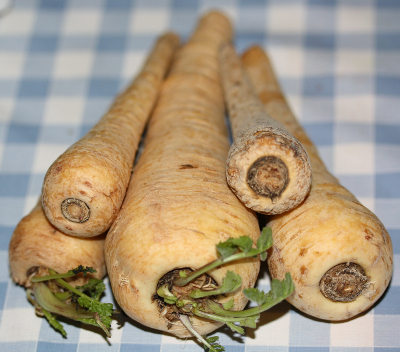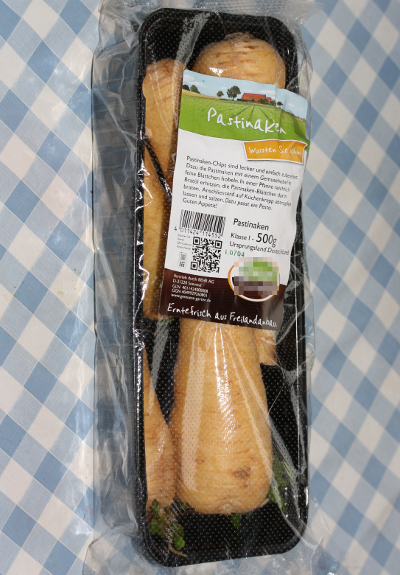Pastinaca, parsnips |

Roots of the parsnip

Parsnips are usually available only in winter
Linnaeus described in 1753 two different species: Pastinaca sativa and P. opopanax. The latter one is familiar as Opopanax chironium. The etymology of the botanical name is uncertain. Possibly it has it roots in Latin pastinum – a short hoe, which was used by winemakers, or in Latin pastus = feed or food. "Parsnip" goes back to the Old French "pasnaie", which in turn is derived from the scientific name. The ending -nip was formed in analogy to "turnip".
The 15 species belonging to the genus of parsnips is found in the temperate zone of Eurasia and was introduced to North America with Pastinaca sativa. They are biannual to perennial herbs with a branched taproot and erect, hollow stems. The leaves are stalked and sheathing the stems. The leaf blade is simply pinnate or pinnatisect, rarely undivided or 2-fold pinnate; the leaflets are serrated, lobed or pinnatifid.
The inflorescences (double umbels) are arranged terminal and lateral. The bracts of the umbel, the so-called involucre, is mostly missing. The umbel with 5 to 20 rays bears few-flowered umbellules, which bears yellow or red flowers whose marginal petals are not or only hardly enlarged. The raylet leaves which form the involucel are mostly missing. The 5 calyx teeth are either clearly visible, stunted to a rim or they are missing. The petals are trimmed at the apex and strongly curled inward.
After insect pollination the inferior ovary forms elongated to inversely egg-shaped, strongly flattened fruits with 10 ribs. They are composed of 2 mericarps with each 5 ribs, their lateral ribs are narrowly winged. The 3 ribs on the back are narrow and slightly angular. Between the ribs there are 4 dark brown oil tubes.
| Floral formula mostly: |
| * K5 C5 A5 G(2) inferior |
Historical publications
Pliny (about 23–79 AD.) described a wild parsnip, that the Greeks would call Staphylinos, and a real parsnip, which one could draw from seeds or roots in spring. After one or better two years it could be harvested. Even by frying it would not lose its pungent flavor. Another kind of parsnip was the Gallic, which was called Daucos by the Greeks.
Dioscorides (1st century AD.) wrote about the Elaphoboskon, the stems resemble the fennel and were branched. The branches would bear umbels resembled the dill. The fruits also look like that of the dill and the flowers were pale yellow. The plant was finger-thick, white, sweet and possessed edible roots. They would be eaten by deers, to be immune to snake bites.
Meanung of the species name
- sativum: lat. sativus = sown, referred useful plants
Interesting notes
The common stingray bears the zoological name Dasyatis pastinaca because its sting reminiscent of the taproot of parsnips.
Parsnip species, similar to the members of the genus Heracleum contain furanocumarines that may cause blisters on the skin. They may develop after touching the plants and under sun exposure.